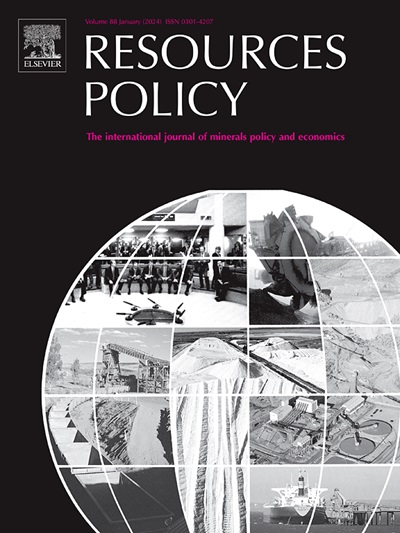Quantifying conflict risks in raw material supply using the INFORM risk index
IF 10.2
2区 经济学
0 ENVIRONMENTAL STUDIES
引用次数: 0
Abstract
Regulations and initiatives focused on responsible sourcing of raw materials have grown in the last decades. So-called “conflict minerals”— typically tin, tantalum, tungsten, and gold (3TG) associated with Democratic Republic of Congo — have been a target for responsible sourcing since 2008. As production of most raw materials has increased, there is need to pay attention to sourcing from conflict-affected or high-risk areas which poses various risks and consequences. To support sustainable and responsible use, companies seek to identify and manage potential risks. Existing tools and initiatives are limited in supporting companies' sustainability goals, as many are generic or are not publicly accessible. This article introduces an open-access tool that provides a product focus, the ConflictRisk method, which assesses the risks associated with sourcing raw materials from conflict-affected and high-risk areas at the country level using publicly available data. Building upon the existing GeoPolRisk framework, this method replaces the governance indicator with the INFORM Risk Index, which provides a direct measure of armed conflict. The ConflictRisk method was demonstrated in a case study considering 52 raw materials imported into the United States, and revealing risks even for materials sourced from outside traditionally recognized high-risk areas. Differences between the ConflictRisk method and existing frameworks, such as the European Union's conflict mineral regulations, underscore the value of a quantitative assessment. The article also presents a framework for integrating the ConflictRisk method into Life Cycle Sustainability Assessment to characterize the impacts of conflict risks. Limitations of the method include its reliance on national-level data, which can restrict the granularity of conflict risk evaluations at the sub-national level. The study also emphasizes the need for comprehensive supply chain analysis and further research to refine the integration of conflict risk into broader sustainability assessments.
使用INFORM风险指数量化原材料供应中的冲突风险
过去几十年来,有关负责任的原材料采购的法规和倡议不断增多。所谓的“冲突矿产”——通常是与刚果民主共和国有关的锡、钽、钨和金(3TG)——自2008年以来一直是负责任采购的目标。由于大多数原材料的生产已经增加,因此需要注意从受冲突影响或高风险地区采购,这将带来各种风险和后果。为了支持可持续和负责任的使用,公司寻求识别和管理潜在风险。现有的工具和倡议在支持公司的可持续发展目标方面是有限的,因为许多工具和倡议是通用的或不公开访问的。本文介绍了一种提供产品重点的开放获取工具,即冲突风险方法,该方法利用可公开获得的数据,评估在国家一级从受冲突影响和高风险地区采购原材料的相关风险。该方法以现有的GeoPolRisk框架为基础,用INFORM风险指数取代治理指标,后者提供了对武装冲突的直接衡量。冲突风险方法在一个案例研究中得到了证明,该案例研究考虑了进口到美国的52种原材料,并揭示了甚至来自传统上公认的高风险地区以外的材料的风险。冲突风险方法与现有框架(如欧洲联盟的冲突矿物条例)之间的差异强调了定量评估的价值。本文还提出了一个将冲突风险方法整合到生命周期可持续性评估中的框架,以表征冲突风险的影响。该方法的局限性包括依赖国家层面的数据,这可能会限制次国家层面冲突风险评估的粒度。该研究还强调需要进行全面的供应链分析和进一步研究,以便将冲突风险纳入更广泛的可持续性评估。
本文章由计算机程序翻译,如有差异,请以英文原文为准。
求助全文
约1分钟内获得全文
求助全文
来源期刊

Resources Policy
ENVIRONMENTAL STUDIES-
CiteScore
13.40
自引率
23.50%
发文量
602
审稿时长
69 days
期刊介绍:
Resources Policy is an international journal focused on the economics and policy aspects of mineral and fossil fuel extraction, production, and utilization. It targets individuals in academia, government, and industry. The journal seeks original research submissions analyzing public policy, economics, social science, geography, and finance in the fields of mining, non-fuel minerals, energy minerals, fossil fuels, and metals. Mineral economics topics covered include mineral market analysis, price analysis, project evaluation, mining and sustainable development, mineral resource rents, resource curse, mineral wealth and corruption, mineral taxation and regulation, strategic minerals and their supply, and the impact of mineral development on local communities and indigenous populations. The journal specifically excludes papers with agriculture, forestry, or fisheries as their primary focus.
 求助内容:
求助内容: 应助结果提醒方式:
应助结果提醒方式:


